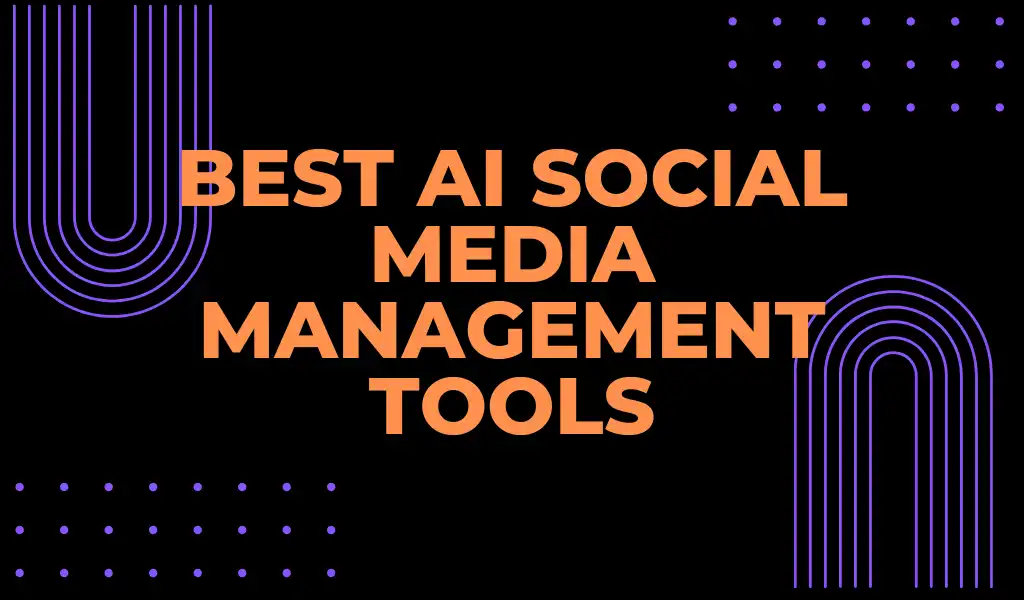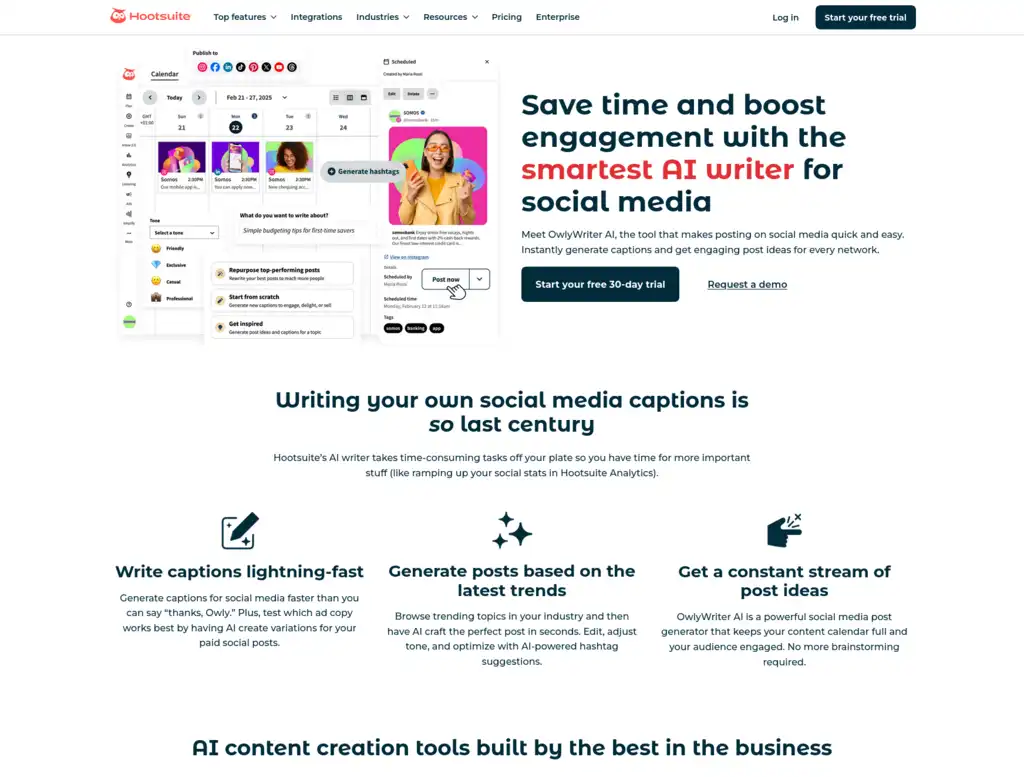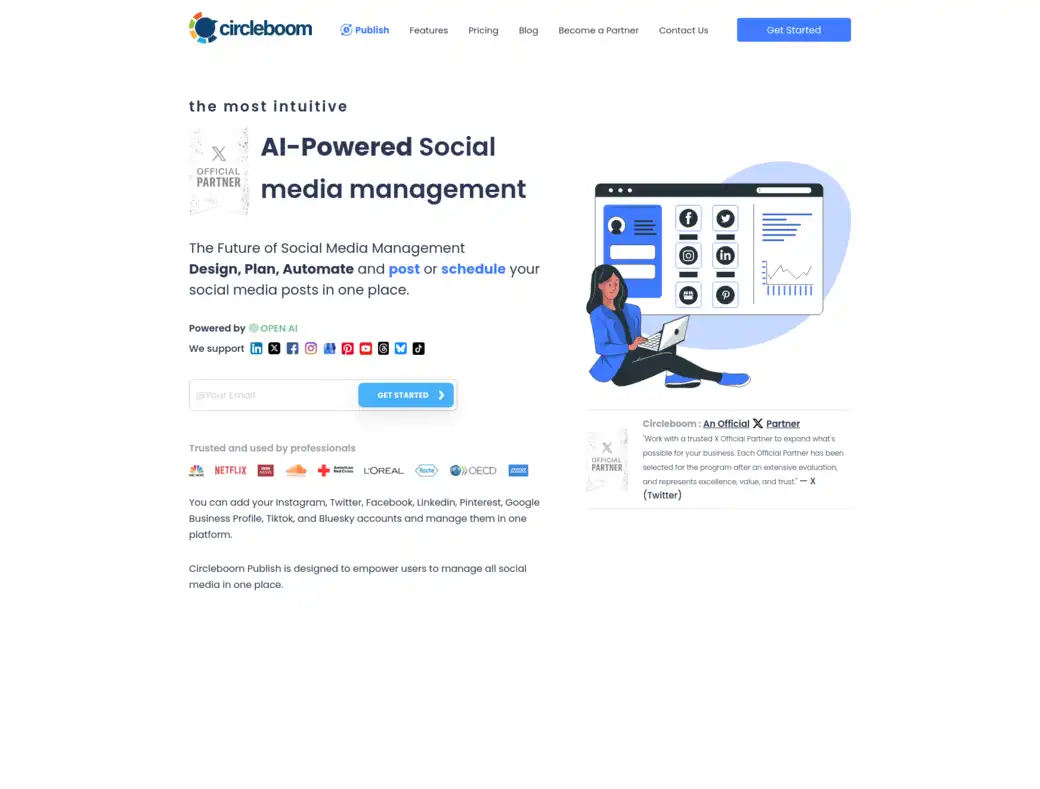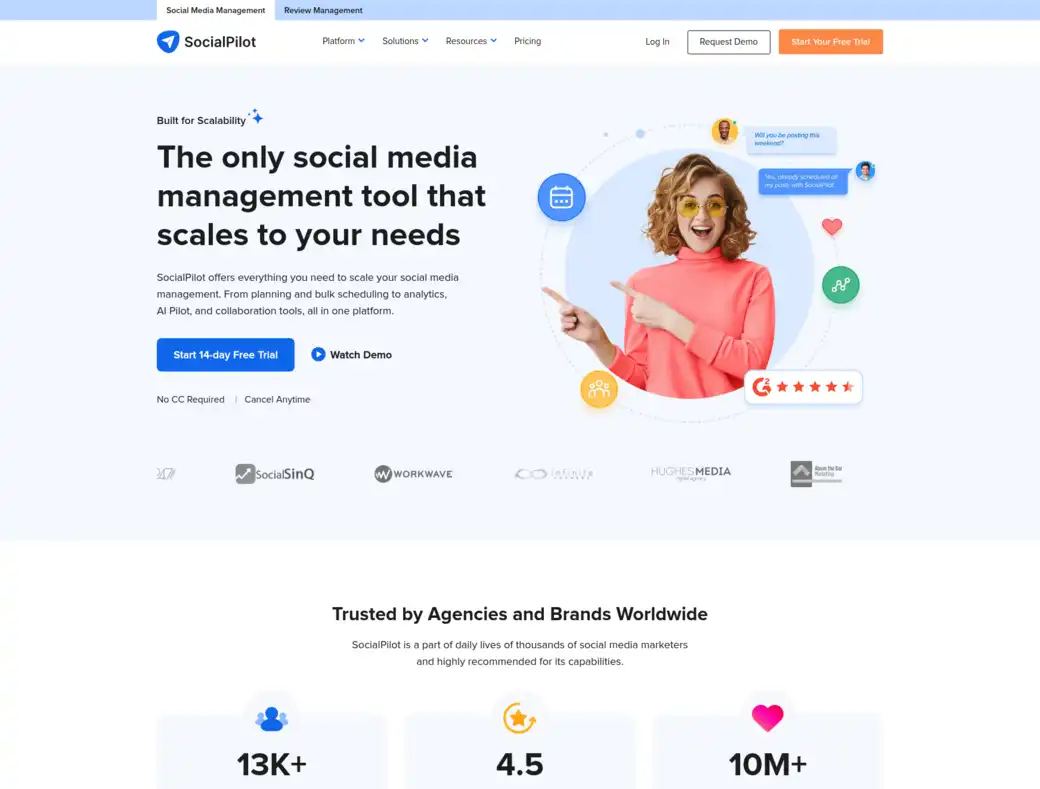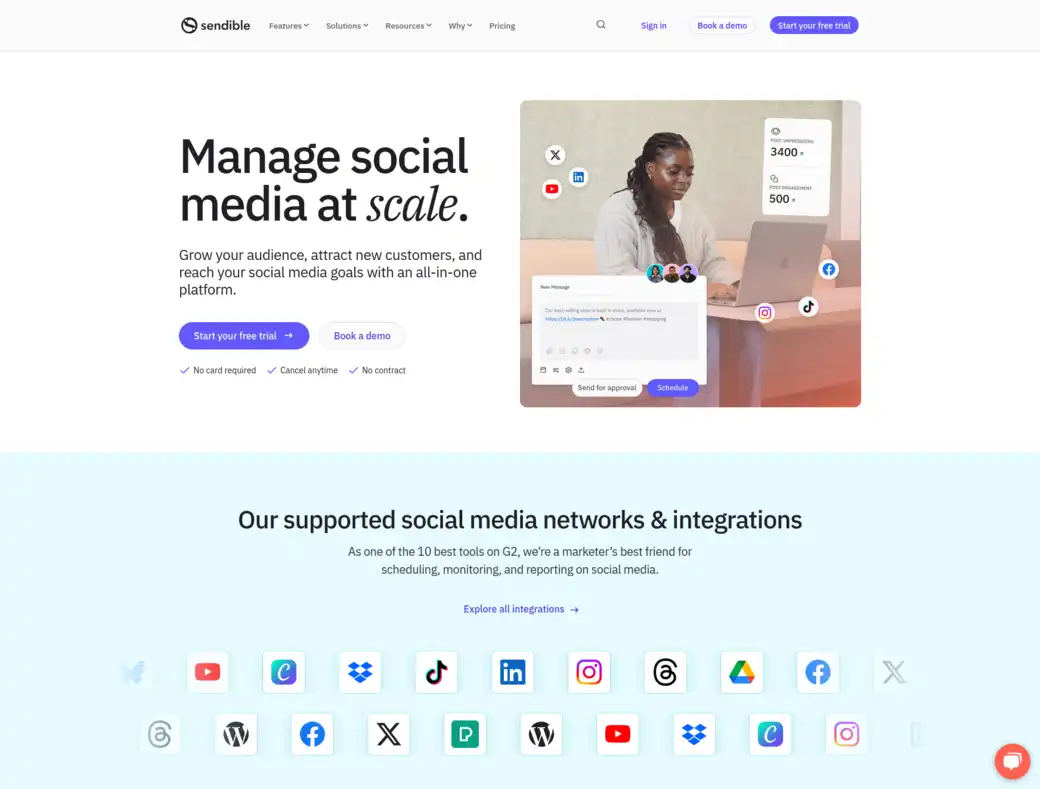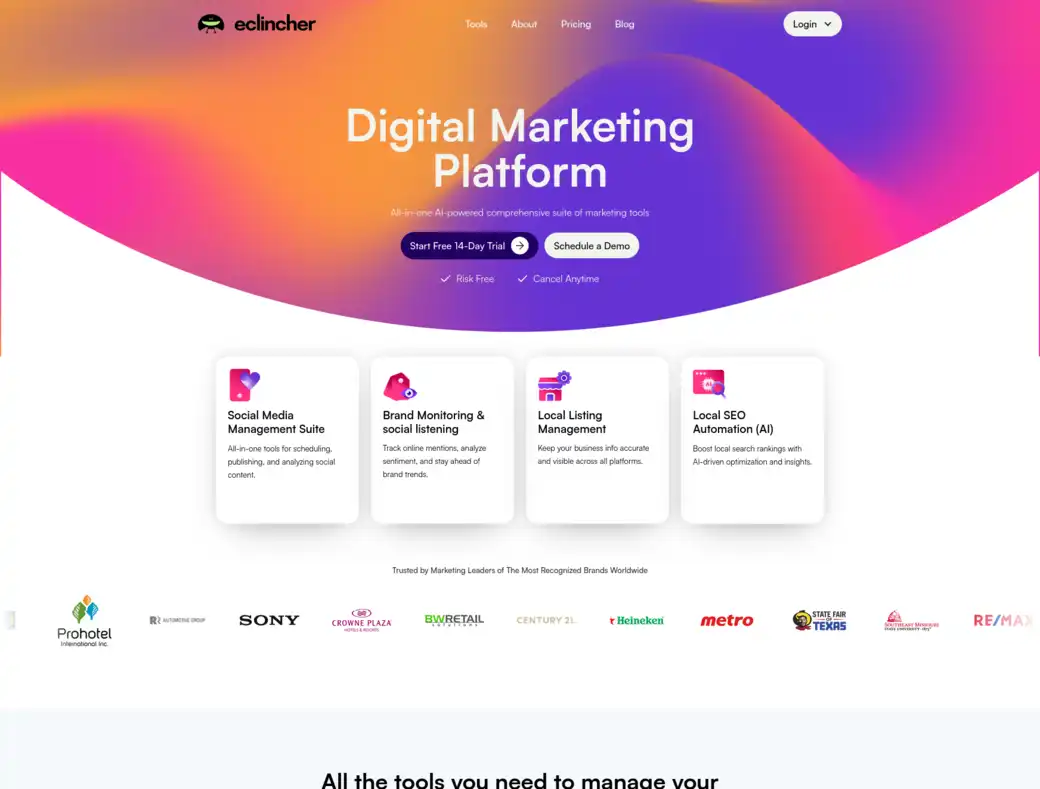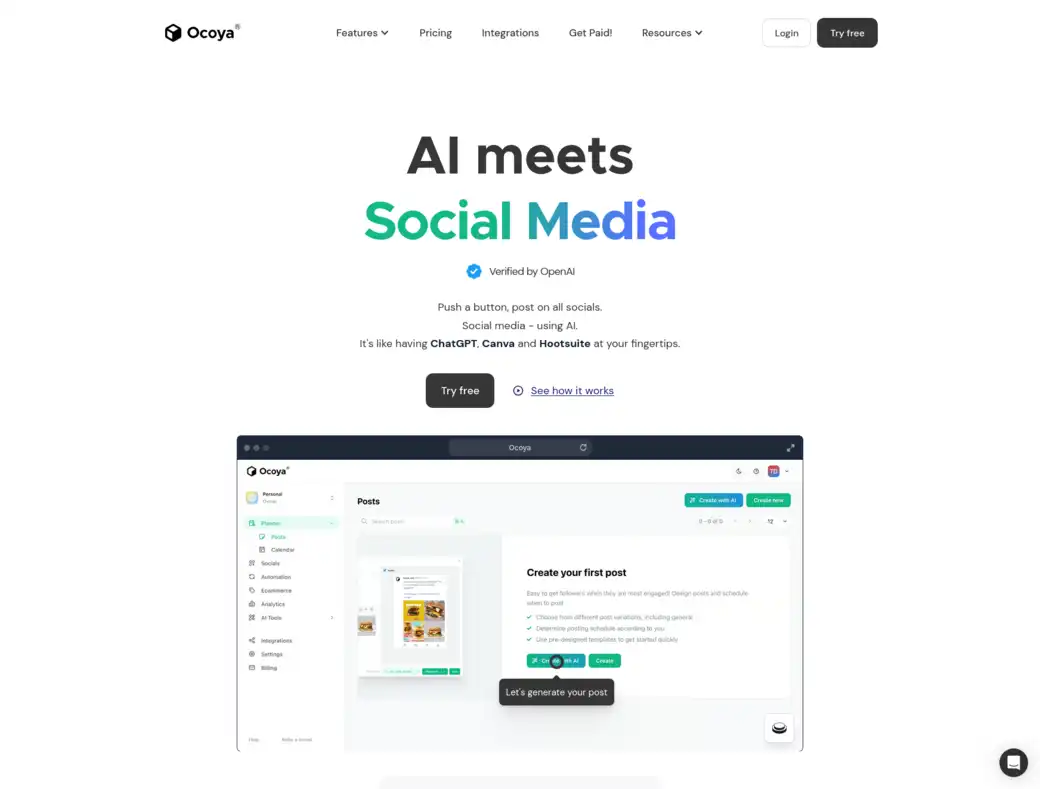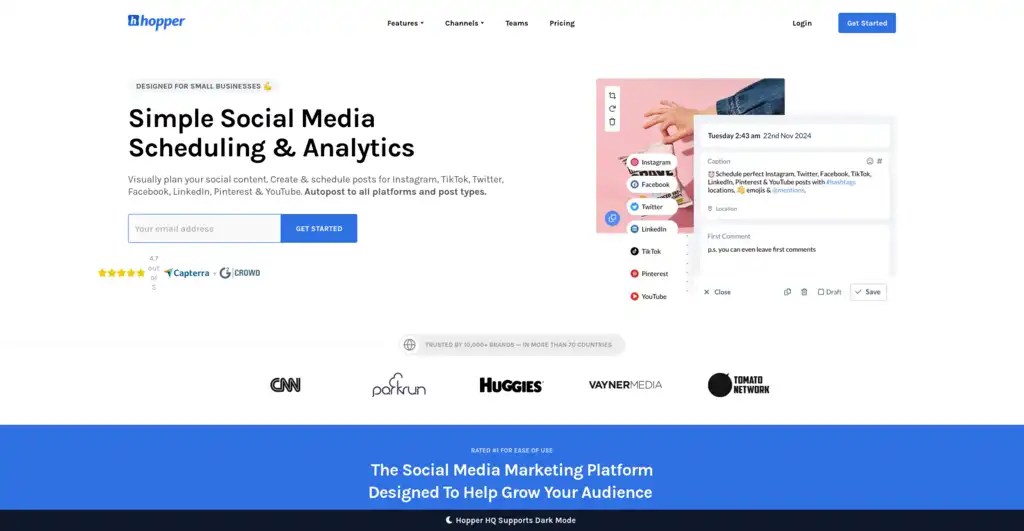10 Best AI Social Media Management Tools for 2025
Managing social media in 2025 requires more than just posting content. AI tools now handle the heavy lifting of scheduling, content creation, and analytics that once consumed hours of your day. We tested the top 10 AI social media management tools that actually deliver results, comparing features and pricing to help you pick the right one for your marketing needs. From solo creators to large teams, these tools offer practical solutions that save time and improve engagement. Let's look at what each one does best, how much they cost, and real examples of how businesses use them.
Tools Overview
Each tool on our list has been evaluated for its ability to manage text, images, and videos, ensuring a comprehensive approach to social media management. We've tested these platforms ourselves, gathering insights from user reviews to highlight their strengths and best use cases. From AI-generated captions to automated scheduling, these tools are your secret weapons for staying ahead in the fast-paced social media landscape.
Creation, scheduling and analytics - Hootsuite
Hootsuite is a leading social media management platform that helps businesses manage their social media presence across multiple platforms.
- Key Features: Scheduling and publishing posts , Social listening and monitoring, AI-powered content creation with OwlyWriter AI, Advanced analytics and reporting.
- Pricing Info: Professional plan starting at $99/month (billed annually) for 10 social accounts.
- Best For: Small to large businesses looking for a comprehensive social media management solution with AI capabilities.
- Example: A digital marketing agency used Hootsuite to schedule posts across multiple client accounts, leveraging OwlyWriter AI to generate engaging content efficiently.
Try Hootsuite
User-friendly scheduling and analytics - Buffer
Buffer is a user-friendly social media management tool that helps individuals and teams schedule and analyze their social media posts.
- Key Features: Post scheduling across multiple platforms, Content curation and discovery, AI Assistant for content variation and repurposing, Basic analytics and reporting.
- Pricing Info: Free plan for limited use, Essentials: $6/month per channel (billed annually), Team: $12/month per channel (billed annually).
- Best For: Small businesses and individuals who need a simple yet effective social media scheduling tool with some AI assistance.
- Example: A solopreneur used Buffer's AI Assistant to generate different variations of their blog post teasers, increasing engagement on their social media channels.
Try Buffer
Advanced customer engagement and analytics - Sprout Social
Sprout Social is a robust social media management platform designed for businesses to manage their social media presence, customer care, and analytics.
- Key Features: Unified inbox for managing messages and comments, Content scheduling and publishing, AI-powered social listening and analytics, Customer care and engagement tools.
- Pricing Info: Standard: $249/month for up to 5 social accounts, Professional: $399/month for unlimited social accounts, Enterprise: Custom pricing.
- Best For: Medium to large businesses that require advanced social media management and customer engagement features with AI integration.
- Example: A retail company used Sprout Social's AI-powered listening tools to monitor customer feedback in real-time, allowing them to address concerns promptly and improve customer satisfaction.
Start using Sprout Social
AI-driven content design and automation - Circleboom Publish
Circleboom Publish is an AI-powered social media management tool that helps users design, plan, automate, and schedule posts across multiple platforms.
- Key Features: AI-generated post suggestions and captions, Content curation and scheduling, Integration with popular design tools like Canva, Detailed analytics and reporting.
- Pricing Info: X Publish: $9.99/month for 1 social account, Pro: $29.99/month for up to 5 social accounts, Premium: $44.99/month for up to 10 social accounts, Business: $89.99/month for up to 30 social accounts, Enterprise: $249.99/month for up to 100 social accounts.
- Best For: Users and brands looking for an intuitive social media management tool with AI-driven content creation.
- Example: A content creator used Circleboom's AI-generated post suggestions to create engaging Instagram captions, saving time and boosting follower interaction.
Try Circleboom Publish today
Comprehensive team collaboration - SocialPilot
SocialPilot is a comprehensive social media management platform that offers scheduling, analytics, and team collaboration features.
- Key Features: Bulk scheduling and content planning, AI Assistant for generating captions and hashtags, Social inbox for managing messages and comments, Detailed performance analytics.
- Pricing Info: Studio: $30/month for up to 10 social accounts, Agency: $60/month for up to 25 social accounts, Enterprise: Custom pricing.
- Best For: Small to medium-sized businesses and agencies that need a feature-rich social media management tool with AI capabilities.
- Example: An advertising agency utilized SocialPilot's AI Assistant to generate relevant hashtags for their clients' posts, enhancing visibility and reach on various platforms.
Try SocialPilot
Local SEO and team management - Sendible
Sendible is an all-in-one social media management tool that helps businesses manage their social media presence efficiently.
- Key Features: Content scheduling and publishing, Social listening and monitoring, AI-powered local SEO insights, Team collaboration and client management.
- Pricing Info: Starter: $29/month for up to 5 social accounts, Pro: $49/month for up to 10 social accounts, Enterprise: Custom pricing.
- Best For: Small businesses and agencies looking for a cost-effective social media management solution with some AI features.
- Example: A local business used Sendible's AI-powered local SEO insights to optimize their online presence, leading to increased visibility in local search results.
Try Sendible today
Local SEO automation and performance analysis - eClincher
eClincher is a social media management platform that helps businesses manage their social media accounts, schedule posts, and analyze performance.
- Key Features: Content scheduling and publishing, Social listening and monitoring, AI-powered local SEO automation, Team collaboration and client management.
- Pricing Info: Basic: $49/month for up to 5 social accounts, Plus: $99/month for up to 15 social accounts, Pro: $199/month for up to 30 social accounts, Enterprise: Custom pricing.
- Best For: Small to medium-sized businesses that need a reliable social media management tool with some AI integration for local SEO.
- Example: A restaurant chain used eClincher's local SEO automation to manage their listings across different directories, ensuring consistent and accurate information for customers.
Try eClincher
Streamlined engagement and reporting - Agorapulse
Agorapulse is a social media management platform that offers scheduling, engagement, and analytics features.
- Key Features: Unified inbox for managing messages and comments, Content scheduling and publishing, Social listening and monitoring, Detailed analytics and reporting.
- Pricing Info: Essential: $49/month for up to 5 social accounts, Advanced: $99/month for up to 10 social accounts, Premium: $199/month for up to 20 social accounts.
- Best For: Small to medium-sized businesses looking for a user-friendly social media management tool with robust features.
- Example: A non-profit organization used Agorapulse's unified inbox to efficiently manage donor interactions and engagement across their social media channels.
Try Agorapulse
Automated evergreen content scheduling - MeetEdgar
MeetEdgar is an AI-powered social media scheduling tool that automates the process of posting content to keep your social media active.
- Key Features: Automated scheduling of evergreen content, AI-powered content categorization and scheduling, Inky AI for generating captions and hashtags, Basic analytics and reporting.
- Pricing Info: Eddie Plan: $29.99/month for up to 5 social accounts, Edgar Plan: $49.99/month for up to 25 social accounts.
- Best For: Individuals and small businesses who want to maintain a consistent social media presence with minimal effort using AI automation.
-
Example: A lifestyle blogger used MeetEdgar's automated scheduling to repurpose their blog content into engaging social media posts, ensuring a steady stream of updates without daily intervention.
Try MeetEdgar today
Multilingual content creation and scheduling - Ocoya
Ocoya is an AI-powered social media management tool that combines content creation, scheduling, and analytics in one platform.
- Key Features: AI-generated marketing text in multiple languages, Visual content creation with images, videos, and music, Planning and scheduling posts across multiple platforms, Advanced analytics and performance tracking.
- Pricing Info: Starter: Free plan with limited features, Pro: $29/month for unlimited posts and basic features, Premium: $49/month for advanced features and priority support.
- Best For: Marketers and content creators who need an all-in-one platform for content creation and social media management powered by AI.
- Example: A digital marketing consultant used Ocoya's AI-generated marketing text feature to create compelling copy for their clients' campaigns in various languages, expanding their reach globally.
Try Ocoya free today
AI social media scheduler - Hopper HQ
Hopper HQ simplifies social media management with AI-powered scheduling and content creation. Our tests showed its visual planner and AI caption generator dramatically reduced posting time across multiple platforms.
- Key features: Visual content calendar, AI caption writing, hashtag generator, grid planner, analytics, multi-platform posting (Instagram, TikTok, X, LinkedIn, Facebook, Pinterest, YouTube Shorts)
- Pricing info: 14-day free trial; paid plans start at $19/month
- Best for: Social media managers handling multiple accounts and platforms
- Example: A small business increased their posting consistency by 75% using Hopper HQ's AI-powered content calendar, leading to 30% higher engagement
| Tool | Description | Key Features | Pricing Info | Best For | Example |
|---|---|---|---|---|---|
| Hootsuite | Leading platform for managing social media presence across multiple platforms. | Scheduling, social listening, AI content creation (OwlyWriter AI), advanced analytics. | Professional: $99/mo (annually), Team: $249/mo (annually), Enterprise: Custom. | Small to large businesses seeking comprehensive AI-driven solutions. | Agency used for client post scheduling, leveraging OwlyWriter AI for content. |
| Buffer | User-friendly tool for scheduling and analyzing social media posts. | Post scheduling, content curation, AI Assistant for variations, basic analytics. | Free plan, Essentials: $6/mo per channel (annually), Team: $12/mo per channel (annually). | Small businesses and individuals needing simple AI-assisted scheduling. | Solopreneur used AI Assistant for blog post teasers, boosting engagement. |
| Sprout Social | Robust platform for managing presence, customer care, and analytics. | Unified inbox, scheduling, AI-powered listening, customer engagement tools. | Standard: $249/mo (5 profiles), Professional: $399/mo (unlimited), Enterprise: Custom. | Medium to large businesses needing advanced AI-integrated management. | Retail company monitored feedback in real-time, improving satisfaction with AI listening. |
| Circleboom Publish | AI tool for designing, planning, automating, and scheduling posts. | AI post suggestions, content curation, Canva integration, detailed analytics. | X Publish: $9.99/mo (1 X account), Pro: $29.99/mo (5 accounts), up to Enterprise: $249.99/mo. | Users and brands seeking intuitive AI-driven content creation. | Creator used AI suggestions for Instagram captions, saving time and boosting interaction. |
| SocialPilot | Comprehensive platform for scheduling, analytics, and team collaboration. | Bulk scheduling, AI Assistant for captions/hashtags, social inbox, performance analytics. | Studio: $30/mo (10 profiles), Agency: $60/mo (25 profiles), Enterprise: Custom. | Small to medium businesses and agencies needing feature-rich AI tools. | Agency generated hashtags with AI Assistant, enhancing client post visibility. |
| Sendible | All-in-one tool for efficient social media presence management. | Scheduling, listening, AI-powered local SEo insights, team collaboration. | Starter: $29/mo (5 profiles), Pro: $49/mo (10 profiles), Enterprise: Custom. | Small businesses and agencies seeking cost-effective AI features. | Local business optimized online presence with AI local SEo, increasing visibility. |
| eClincher | Platform for managing accounts, scheduling posts, and analyzing performance. | Scheduling, listening, AI-powered local SEo automation, team collaboration. | Basic: $49/mo (5 profiles), Plus: $99/mo (15 profiles), Pro: $199/mo (30 profiles), Custom: Enter | Small to medium businesses needing reliable AI for local SEo. | Restaurant chain managed listings with AI automation, ensuring accuracy for customers. |
| Agorapulse | Platform offering scheduling, engagement, and analytics features. | Unified inbox, scheduling, listening, detailed reporting, potential AI in automation. | Essential: $49/mo (5 profiles), Advanced: $99/mo (10 profiles), Premium: $199/mo (20 profiles). | Small to medium businesses seeking user-friendly robust features. | Non-profit managed donor interactions efficiently with unified inbox. |
| MeetEdgar | AI-powered tool for automating content posting to keep social media active. | Automated scheduling, AI content categorization, Inky AI for captions/hashtags, basic analytics. | Eddie Plan: $29.99/mo (5 profiles), Edgar Plan: $49.99/mo (25 profiles). | Individuals and small businesses wanting minimal-effort AI automation. | Blogger repurposed content with automated scheduling, ensuring steady updates. |
| Ocoya | AI-powered tool combining content creation, scheduling, and analytics. | AI marketing text in multiple languages, visual content creation, scheduling, advanced analytics. | Starter: Free (limited), Pro: $29/mo (unlimited posts), Premium: $49/mo (advanced, priority). | Marketers and creators needing all-in-one AI-driven platform. | Consultant created multilingual copy with AI, expanding global client reach. |
| Hopper HQ | AI social media scheduler and content planner | Visual calendar, AI captions, hashtag generator, analytics | 14-day free trial, paid from $19/month | Social media managers with multiple accounts | Small business increased posting consistency by 75% |
Narrative Insights and User Feedback
Our testing revealed that Hootsuite's OwlyWriter AI is a game-changer for content creation, with users praising its ability to generate engaging posts, as seen in reviews from Influencer Marketing Hub. Buffer's AI Assistant, while simpler, was lauded for its ease of use, with a user on TrustRadius noting, "AI-generated captions save me hours weekly." Sprout Social's AI-powered listening tools were highlighted for real-time insights, with a case study on Sprout Social showing improved customer satisfaction.
Circleboom Publish stood out for its AI-driven content suggestions, with a Capterra review stating, "Intuitive and results displayed in seconds," ideal for quick content planning (Capterra UK). SocialPilot's AI Assistant was praised for hashtag generation, with a user on AppSumo appreciating its Canva integration. Sendible's AI for local SEo was less prominent but noted in SoftwareAdvice, with users valuing its cost-effectiveness.
eClincher's AI features, such as local SEO automation, were confirmed through GetApp, with users appreciating its comprehensive suite. Agorapulse, while not explicitly AI-focused, showed potential in automation, with Hot in Social Media Tips and Tricks mentioning an AI writing assistant, aligning with user-friendly features. MeetEdgar's Inky AI was a hit for caption generation, with TechRadar reviews noting its efficiency. Ocoya, heavily AI-driven, was celebrated for multilingual text generation, with FireBear highlighting its all-in-one approach.
Conclusion and Recommendations
This survey underscores the transformative potential of AI in social media management, offering tools that cater to diverse needs from content creation to analytics. For small businesses, Buffer and MeetEdgar offer cost-effective AI solutions, while agencies might prefer SocialPilot or Hootsuite for robust features. Large enterprises can leverage Sprout Social or Ocoya for advanced AI integration. We encourage you to explore these tools, leveraging their free trials and user reviews to find your perfect fit in 2025's dynamic digital landscape.

